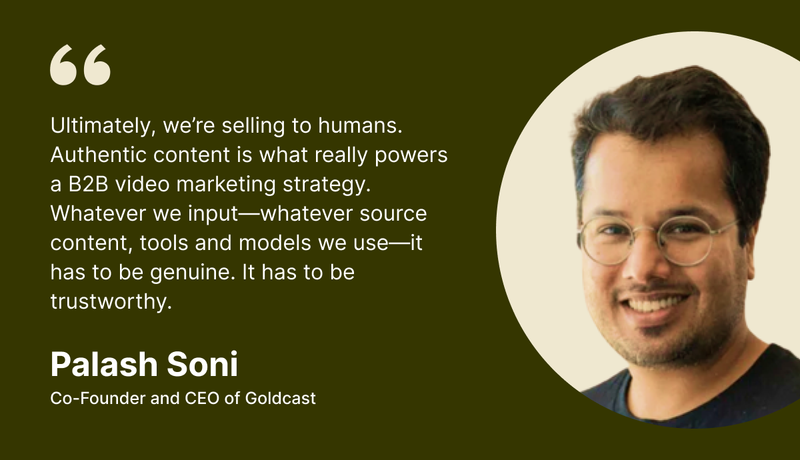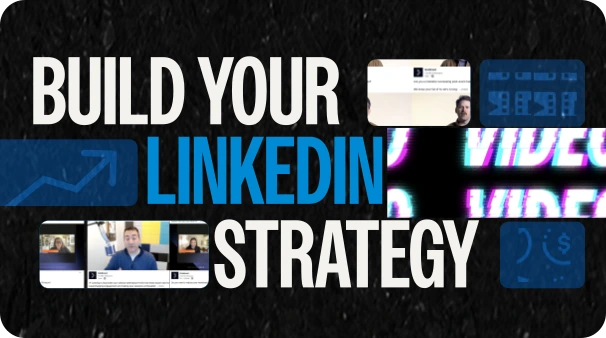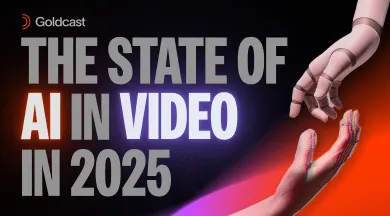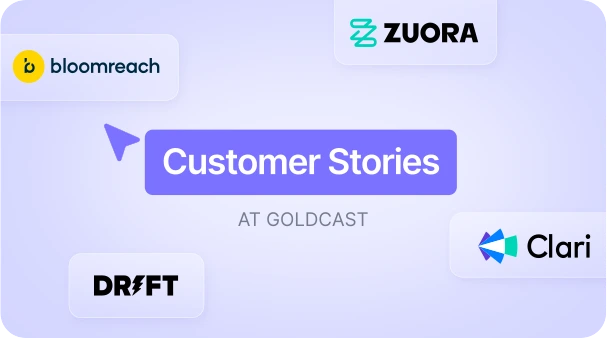Shaping the Future of B2B Marketing with Video

Table of Contents
Maximize Your Marketing ROI
Join 10,000 other marketers already getting the best tips on running engaging events that boost pipeline and create raving fans.
Here. There. In 2024, video is everywhere.
With 92% of marketers reporting positive long-term ROI on video content, video marketing is moving swiftly from ‘shiny object’ to ‘table stakes’ marketing tool. But that doesn’t mean it’s easy.
In a competitive landscape, you need to make sure each and every video is authentic, professional and capable of engaging your audience.
That’s where AI enters the chat.
In our recent panel discussion, Goldcast CEO, Palash Soni, sits down with Heike Young, Senior Director, Content Strategy at Salesforce, Liza Adams, AI Advisor & Fractional CMO at GrowthPath Partners, and Tim Duranleau, SVP Global Marketing at Medallia, to find out how video is shaping the future of marketing, plus practical ways AI can help marketers stay a step ahead.
Read on for:
- Video marketing: why B2B marketers can no longer opt out
- 4 best practices for getting more out of every video
- AI isn’t a silver bullet, but it can definitely help
Want to tune into the entire conversation? Access the recording now and dive into the discussion on all things video marketingI!
Video marketing: why B2B marketers can no longer opt out
According to HubSpot, 80% of consumers prefer watching live stream or online video. Yet only 26% of marketers plan to invest more in short-form video.
The truth is, even with an increasingly wide range of automated video tools, creating video content isn’t as easy as picking up your iPhone and hitting record. In fact, when we polled our audience, only five attendees said video is central to their current marketing strategy. So, what gives?
“In the past, a lot of content marketers opted out of making video because it was too expensive or too time-consuming to create,” explains Heike. “With AI, the reality is every marketer will be creating a ton of videos, fast. So the question is, how quickly will you adopt new tools to make your creation and distribution process faster and more effective.”
It takes more than just a great idea to launch a video-first content strategy. It’s about publishing, distributing, and creating a highly efficient content assembly line that never cuts corners on quality. “If you’re not thinking about how to do that, other marketers in your space are,” Heike cautions.
It might sound scary at first, but when you consider how much more juice you can squeeze out of your next great idea by using an AI-powered video strategy, you can begin to see why so many marketers are reporting positive ROI on video.
4 best practices for getting more out of every video
When we asked how marketers are incorporating video into their B2B strategies, the majority of attendees said they were using video only occasionally for specific campaigns (7%), and even fewer said they were regularly using video across multiple campaigns (3%).
1. Keep your content authentic
Today, video is at the center of discoverability. Whether it’s ChatGPT, Gemini, Perplexity, Claude, or even Google, searchers are relying more and more on AI to help them find the answers they need.
“We now have AI standing between us and our customers,” says Liza. “Video allows us to create a much richer response when these inquiries come in.” She believes, “AI will actually push us to be authentically human, which is ironic…but the reason for this is that our radars are up right now, because there’s so much content being created.”
The time to start winning searchers over, is now.
“Right now, video can be a competitive advantage. Over time, it will simply put us at par. And if we wait too long, we will be in catch-up mode,” Liza predicts.
To start creating a relevant and authentic video marketing strategy, start by using AI to:
- Collate insights from reviews and social comments to understand customer sentiment more deeply
- Discover key terms of art in a given industry or ‘field’ to personalize and localize your content
- Find out how customers like to consume your content
2. Prioritize quality over quantity
When it comes to variety of content, Heike Young has seen it all.
“Quality over quantity has never been more important. With video, people are deciding in a split second if they want to watch that video or scroll past on YouTube, LinkedIn, TikTok, etc. Humans are going to be more important than ever,” she explains.
But how can you guarantee a quality end result without blowing your budget on a professional videography team? According to experts like Heike, the key is to begin with the end in mind.
“I try to think about editing the final clips when I do a webinar or podcast. For example, I try to get right to the point, take a short beat before answering, and avoid talking too much about how I’m on a webinar,” she says.
She’s seen firsthand that authentic, relatable, and informative videos perform best. But video is an entirely different muscle to flex compared to traditional formats like text.
Here are some top tips to help you nail it:
- Speak clearly and slowly: If you’re a fast talker, keep in mind that many people will watch or listen to your video at 1.5X speed. By slowing your pace, you help both your audience and your transcribing tool.
- Don’t sweat the pauses: Dead air in a webinar or podcast can bring on the anxiety, but according to experts like Heike, it’s actually a good thing! People’s ears perk up if they hear a quick beat of silence, which can also make life easier during the editing process.
- Use a strong setup: A strong aesthetic is key to your success with video. But at the end of the day, editing can only do so much. Go beyond strong background and lighting, to also check your internet stability, camera and video backgrounds.
- Get to your point quickly: Rambling doesn't make for a great clip (or a great event). Know your talking points, avoid filler words, and stick to the message.
3. Use AI as an enabler
When we polled the audience, the #1 top concern cited when integrating AI into video marketing was authenticity and quality—ahead of both ‘lack of technical expertise’ and not knowing ‘where to start’.
While AI can enhance authenticity and personalization, it’s not yet capable of replicating human-based videos in a way that feels authentic to viewers.
For experts like Tim, the trick to walking the line between authenticity and scalability is to utilize AI to tailor video content for different stages of the buyer journey, from awareness to decision.
AI can enable you to offer more value in your video content by delivering:
- Deep customer insights: That, according to Tim, can help you put “the right content in front of the right person at the right time in the buying journey.”
- Automatic translations: Tim and his team can get in front of a global audience quickly by tapping into the power of AI for rapid content localization.
- Shorter-snippets from long-form source material: Tim’s not going to ask viewers to sit and watch a two-hour event recording. Instead, he uses AI to repurpose long-form videos into personalized, 20-second clips that make the viewer feel like he’s speaking directly to them.
4. Track and measure pipeline
Video is no longer just for product overviews and case studies.
But measuring the impact of video throughout the funnel requires strong alignment between your video strategy and broader strategic goals. It’s also critical to track video touchpoints and incorporate those moments into your existing attribution models.
For Tim, the logic is easy to understand. It’s the execution that can be a bit trickier.
“One of the big responsibilities of marketing is to drive pipeline. And pipeline doesn’t just come from anywhere. Pipeline comes from engagement. Engagement comes from content consumption. A lot of the data shows that the way people want to consume content is through video,” he explains.
His advice? Train yourself to constantly ask where in the buyer’s journey video can play a key role. Here are some key questions to start with:
- How can you align your video use cases with your strategic initiatives?
- What early video use cases that you can grow over time?
- How will you measure the before and after effects of AI implementation?
Building a video-first content strategy: AI isn’t a silver bullet, but it can definitely help
One thing our panelists agree on: there is no video-first strategy without authentic content.
But in the age of snackable content, the pressure to keep up is overwhelming. The ‘more with less’ ethos continues to dominate board rooms. Marketers are constantly called upon to produce more content faster. And the harsh reality is, you're only as relevant as your last post or ad campaign.
“Video is undeniable. It’s how we consume content,” says Palash. He’ll be the first to tell you that even though “AI is our friend in this,” there’s no room for corner-cutting when it comes to the quality of your video content.

That’s why events are the best place to start. Unlike scripted stock videos, video content from digital events and webinars are authentic by nature. And with a purposeful, human-led approach, AI can help you make the most of the event content you and your team already work so hard to create.
Get real insights from real marketers on fact vs. fiction with AI in video marketing. Watch the recording now!
Stay In Touch
Platform
Resources
Company
Community
© 2025 Copyright Goldcast, Inc. All rights reserved.



 Upcoming Events
Upcoming Events Event Series
Event Series On-Demand Events
On-Demand Events

